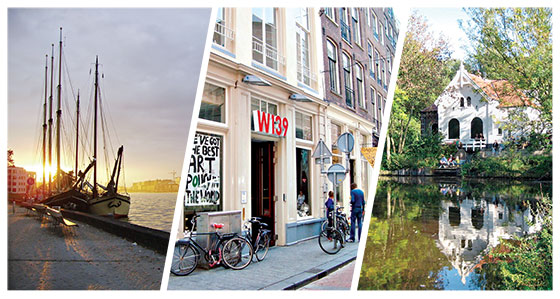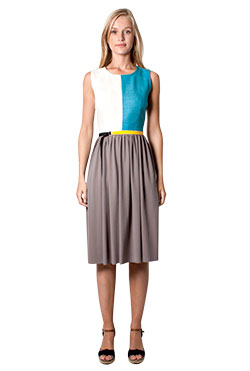
Paint the Canals Red
A trio of night-crawling Amsterdammers on where to go after dark.
See and Be Seen
—Edward Liddiard, copywriter and screenwriter
Start Here:
“Le Patron (Vijzelgracht 63, De Weteringschans; 20-627-3747) is a lads bar, but a lot women go, too. It’s a great place to watch Ajax games. You also find TV presenters and actors, all up close and personal. Ruben van der Meer, a comedian, hangs out all the time.”
Go Here Next:
“The techno club Trouw (Wibautstraat 127, Amsterdam-Oost; 20-463-7788) just got a 24-hour license. It’s located in an old pressing room of a major Dutch newspaper, which makes it feel industrial. The people are fashionable, international, but it’s not flashy at all—boy, girl, gay, straight, doesn’t matter. Just don’t show up in a suit and tie.”
Party With Squatters
—Emma Wierda, chef and activist
Start Here:
“One of Amsterdam’s unique features is its mass of publicly squatted spaces—like OCCII (Amstelveenseweg 134, 20-671-7778), which was legalized 24 years ago and is arguably the godfather of Amsterdam’s underground. The complex hosts shows, classes, and events, and there’s a vegan restaurant called MKZ where you can get a three-course meal for around €5.”
Go Here Next:
“The Vondelbunker (Vondelpark; vondelbunker.nl) was used as a bomb shelter during World War II. It’s now home to an art-focused squat collective called Schijnheilig, or ‘hypocritical.’ They host free rock shows most Saturdays and Sundays starting around 9 p.m., as well as film nights, art expos, and underground electro-techno parties.”
Have a One-Night Stand
—Mark Visbeek, editor of Overdose.am
Start Here:
“At Bloemenbar (Handboogstraat 15, Centrum; no phone), the average age is maybe 25. There’s a big open dance floor and a balcony above it. The music starts off with indie rock, then moves to dance later. Each table has a telephone you can use to call other tables, in case you want to chat up someone across the club.”
Go Here Next:
“Club Roque (Amstel 178, Centrum; no phone) is actually a gay club, where guys go to cruise. But they have a new mixed-gender night on Fridays called Chaos. It’s still very underground, but it’s the talk of the town right now.”
Seeking the Next Vermeer
With two of the city’s major museums largely out of commission, local galleries and other institutions seized upon the opportunity to attract a new audience. As a result, the alternative art scene in Amsterdam is booming. Here, an abridged tour through art collector and urban planner Kai van Hasselt’s favorite places to scope out the next generation of up-and-comers.
Jeanine Hofland Contemporary Art
“Hofland opened this in a converted shop, so it still has bare wood floors—it’s the most Lower East Side gallery in the city. She represents conceptual artists like Maarten Overdijk and Rebecca Digne and does a lot of interesting projects. Last year, she did a mini art fair, for example, where she invited a bunch of foreign galleries to show in her space.” De Clercqstraat 62, Amsterdam Oud-West; 20-753-1596.
Ellen de Bruijne Projects
“This is my favorite gallery in Amsterdam, and it’s on the second floor, which makes it feel like a bit of a secret. Ellen is a really good artist finder—she’s great at discovering young people who sooner or later go on to have really amazing careers, like Lara Almarcegui, who represented Spain at the Venice Biennale.” Rozengracht 207 A, Jordaan; 20-530-4994.
Martin Van Zomeren
“Van Zomeren is very international. He started the gallery with a lot of foreign artists who were at art schools here in the city, as well as some locals. There’s a Dutch duo he represents, Maurice Scheltens and Liesbeth Abbenes, who started out in commercial photography, but took it to an abstract level; like, they would put an object on a turntable, then use a long shutter time to shoot it as it spun around.” Prinsengracht 276 hs, Jordaan; 20-420-8129.
Lumen Travo Gallery
“Gallery owner Marianne van Tilborg works with a lot of artists from Africa. One of my favorites, Otobong Nkanga, is from Nigeria and does these performances and makes some of the most extraordinary drawings, which all touch on the powerful boundaries created by oil, money, corruption, and gender structures in her native country.” Lijnbaansgracht 314, Grachtengordel-Zuid; 20-627-0883.
De Appel Arts Centre
“This nonprofit art space, located in an old music-school building, is right near Central Station, looking over the water toward the new Amsterdam Public Library. They have a great exhibition space where they show all kinds of established, mid-career artists, like Bjarne Melgaard and Mika Rottenberg.” Prins Hendrikkade 142, Centrum/Nieuwmarkt; 20-625-5651.

The Bushwicks of Amsterdam
After you’ve checked off the Anne Frank House, Van Gogh Museum, and Dam Square, traverse the canal rings to explore three emerging neighborhoods.
Amsterdam-Noord
For centuries, Noord was populated by industrial and dock workers, cut off from the rest of the city by the massive IJ canal. But low prices and space have driven the young, creative, and broke outward and upward.
Says Elien Van Riet, community manager for ILoveNoord.com: “Curious Orange (Van der Pekstraat 40; 65-310-3738) has very cute china cups and mirrors, while Attic Empire (Van der Pekstraat 61 hs; 20-789-2471) has great vintage. The Hotel de Goudfazant (Aambeeldstraat 10 H; 20-636-5170) is affordable haute cuisine. For dessert, try IJskoud de Beste (Meeuwenlaan 331; 64-202-2976), which has 36 kinds of ice cream. Al Ponte (Meeuwenlaan 2; 64-208-7482), meanwhile, is by the water and run by an Italian lady—she makes the best coffee in Amsterdam.”
The Red-Light District
About five years ago, the city decided to class up the area, consolidating the prostitution windows onto select streets and encouraging artists and designers to move into vacant storefronts. Now it’s got galleries, shops, restaurants—even its own online radio station.
Says Afaina de Jong, architect and publisher: “W139 (Warmoesstraat 139; 20-622-9434) is a gallery where a lot of Dutch artists from the eighties started, including Marlene Dumas. It still feels like an underground art space. Rambler (Zeedijk 54; 20-752-7076) is a studio that recruits troubled kids to work in fashion design. It creates two collections a year. And Mata Hari (Oudezijds Achterburgwal 22; 20-205-0919) is a bar and restaurant that opened up last year in what used to be a sex club—it has a modern feel that doesn’t allude to its history at all.”
Amsterdam-Oost
The east end is home to the city’s immigrant population—from Indonesia, Suriname, and other parts of the former Dutch empire. The low-cost housing has begun to attract arty types, and the neighborhood seems to be at a turning point.
Says Aron Friedman, D.J. and journalist: “The Dappermarkt (Dapperstraat 279; no phone) street market is nice for people-watching, but you can also find strange things, like a dish rack in the shape of a mosque. Studio/K (Timorplein 62; 20-692-0422) is a multiuse complex in an old trade school—they have club nights, a restaurant, and an alternative movie house. There’s also a little bar in beautiful Flevopark called Nieuwediep (Flevopark 13; 20-465-0222). It’s on the water and very relaxing.”
Dress Like a Local
Nannet Van Der Kleijn,a publicist for Amsterdam Fashion Week and the former creative director of the Amsterdam Fashion Institute, on where you should be shopping.

The arty concept store:
SPRMRKT
Rozengracht 191-193, Jordaan; 20-330-5601
“SPRMRKT is very much about owner Nelleke Strijkers. She’s bohemian and crunchy but has this wild-rocker side. She carries avant-garde Dutch brands like Avalon—all very raw and rock and roll—but I like her store brand, SPR+. The last thing I bought was a cardigan that she designed, made by Bosnian war widows. Just hang out there on a Saturday; it’s great for people-watching, and she’s always changing up the art installations.”
The high-end homey boutique:
Tamago
Spiegelgracht 13, Centrum; 20-626-6054
“Tamago mixes very now designers with vintage. Even the way owner Christine Van Lindt puts things on the rack is inspiring. I go there particularly for Dutch designer Marcha Hüskes (left), known for her Mondrian-like color-blocked dresses.”
The denim mecca:
Denham
Prinsengracht 493, De Negen Straatjes; 20-331-5039
“This denim chain is really Dutch—typical Amsterdam. The flagship store only offers men’s jeans, and it’s clean, white, but also very raw; it’s all about craftsmanship here, and everything is designed and made at their offices on the canal. The jeans are on display next to the tools used to make them—it’s like a museum.”
The massive flea market:
IJ-Hallen
T.T. Neveritaweg 15, Amsterdam-Noord; ijhallen.nl
“This flea market takes place on the first Saturday and Sunday of the month and features 750 stalls. Some sellers are collectors, but there are also just people who have too much in the attic—jackets, vintage hats, a whole bunch of petticoats. I bought some beautiful Sophia Loren glasses from the sixties for like $8 and snakeskin boots for $20.”